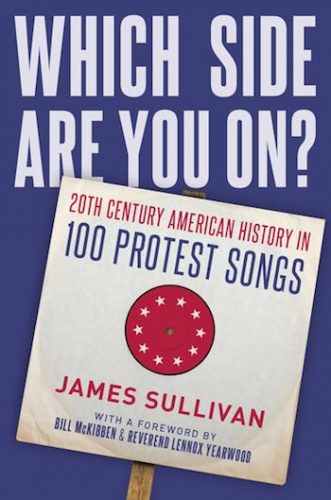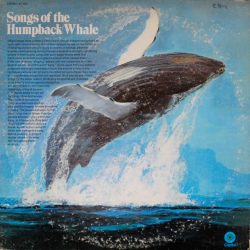Book Review: “Which Side Are You On?” — American History, Skimmed Over
By Adam Ellsworth
In its efforts to cram so much information into so small a space, the narrative becomes unfocused.
Which Side Are You On? 20th Century American History in 100 Protest Songs, by James Sullivan. Oxford University Press, 240 pages, $24.95.

James Sullivan’s Which Side Are You On? 20th Century American History in 100 Protest Songs is admirably wide-ranging, but ultimately disappointing. Wide-ranging in that it truly attempts to cover each of the major social movements of 20th century America and the soundtracks that helped to fuel them. This means Sullivan is able to do more than simply stick to the “classic” dissents of the rock and folk-era, most of which focused on civil rights and the Vietnam War. The result is chapters on civil rights and anti-war/non-violence are included, but so are sections devoted to the fights for the environment, gay rights, women’s rights, worker’s rights, immigrant rights, free speech, and denuclearization.
At its best, the book is able to give equal coverage to the movements and the music, weaving the stories of each together into one narrative. Sullivan’s chapter on the environmental movement that began in the early ’70s is the closest he comes to achieving and sustaining this balance between the tunes and the topical. He begins with the Beach Boys 1971 pollution protest “Don’t Go Near the Water,” which leads him into a line backwards, from the 2010 Deepwater Horizon oil spill in the Gulf Coast and the 1989 Exxon Valdez disaster to the 1969 oil spill in California’s Santa Barbara Channel that eventually inspired the creation of the Environmental Protection Agency as well as the first Earth Day celebration. It’s wonderful storytelling and a fine use of a song as the way into explaining the history of such an important (and ongoing) struggle.
As the chapter continues, Sullivan touches on the “back to the land movement,” the launch of the magazine the Whole Earth Catalogue, and Rachel Carson’s classic takedown of the chemical industry and the extensive use of pesticides, Silent Spring. Sprinkled throughout are descriptions of songs including “Going Up the Country” by Canned Heat, Joni Mitchell’s “Big Yellow Taxi,” and Marvin Gaye’s “Mercy Mercy Me (The Ecology).”
The high-point of the section comes when Sullivan turns his attention to the 1970 album Songs of the Humpback Whale. As the title of the record implies, Songs of the Humpback Whale is a collection of recordings of male humpback whales during breeding season. Two of the recordings on the album were made by Navy engineer Frank Watlington, while an additional three were made by the biologists Roger and Katy Payne, who were the driving forces in compiling and releasing Songs of the Humpback Whale. To include a record of whales singing in a book about protest songs is a bold move, but one completely justified. For one thing, the recordings literally are songs, in the sense that they have a structure and include repetition, just like any good pop song. And, unlike the other 99 tracks showcased in Which Side Are You On?, Songs of the Humpback Whale wasn’t released to support a social struggle or protest movement; it existed to create a movement. The ubiquity of the phrase “Save the Whales,” and the moratorium on commercial whaling launched by the United Nations two years after the release of the album is proof that the record succeeded in its aims. More than any other recording covered in the book, Songs of the Humpback Whale changed the world.
Yet, even in the most successful chapter of Which Side Are You On? there are head scratching moments representative of the problems with the book as a whole. Take the inclusion of the Crosby, Stills, Nash, & Young song “Find the Cost of Freedom.” The track, which was the B-side to the far better known “Ohio,” certainly is a protest song, but its message is antiwar, not pro-environment. Sullivan includes it in his chapter on the environment because of its lyric, “Mother Earth will swallow you, lay your body down.” In short, the fact that Mother Earth is mentioned is enough to qualify it.

When the subtitle of Which Side Are You On? is considered, there is a certain logic to including “Find the Cost of Freedom” in the portion of the book devoted to the environment. After all, the book is not meant to be a history or protest songs, divided up by the subject of the song’s ire, but “20th century American history in 100 protest songs.” As the environmental movement grew, Sullivan writes that the “new environmentalists trusted that Mother Earth had her own voice, and she was letting her inhabitants know that they were abusing their stewardship.” In essence, the idea of “Mother Earth” acting as an actual person was “in the air.” CSN&Y picked up on it and put it in a protest song and, therefore, it is perfectly reasonable to use that song as a way of explaining a portion of the history of the environmental movement.
This explanation is intellectually satisfying for approximately two seconds. “Find the Cost of Freedom” simply isn’t about environmentalism. To include it alongside records such as “Don’t Go Near the Water,” “Big Yellow Taxi,” or Sounds of the Humpback Whale, which are about protecting the natural world, is silly. That it was included as one of the “100 protest songs” of the subtitle, and specifically placed in the chapter concerned with the environment, makes absolutely no sense. It was probably dropped in because 100 songs is a lot of songs and Sullivan needed to get to that number somehow. If this was the only time this kind of padding occurred in Which Side Are You On? it could easily be forgiven — but it happens throughout the book. “Find the Cost of Freedom” is hardly the worst offender either. That distinction goes to the insertion of Nirvana’s “Smells Like Teen Spirit” in the chapter on the freedom of speech, for reasons that remain elusive.
Even when songs aren’t dropped into a chapter, seemingly at random and to meet a quota, Which Side Are You On? often falls short. Sullivan ends his chapter on the environment with paragraphs devoted to Michael Jackson’s “Earth Song.” In terms of subject matter, there can be not objection. But Sullivan never ties the song to any larger developments in the environmental movement during the late-‘80s (when the song was written) or the mid-’90s (when it was released). Even if Jackson wasn’t actually inspired by any of these developments, it still would be interesting context to provide. That “Earth Song” was the final song Jackson ever sang (on the day he died, it was the last tune he rehearsed while preparing for what was to be his farewell performances) and that a version was performed during the Grammy Awards in tribute to him, gives it extra weight. Frankly though, of all the things Michael Jackson will be remembered for, “eco-warrior” won’t crack the top hundred. The addition of the song in the chapter serves no purpose other than to say, “Even the King of Pop wrote an environmental song! This movement must be important!”

It may seem unfair to spend so much of this review on a single chapter, especially when the book covers so much other ground. But the section on the environment was the only part of Which Side Are You On? that excited me as a reader and showed me what the collection had the potential to be. That this slice of the book was also filled with so much that aggravated me — and reminded me of what made other chapters so unsatisfying — shows just how frustrating Which Side Are You On? is.
Take the chapter on civil rights, which should have been a slam dunk for a book focused on the connections between American social movements and the protest songs that powered them. Sullivan provides much information about the movement, though there’s too much bouncing around and it was hard to spot a true narrative. When he turns his attention to civil rights music, what is presented seems incomplete. Bob Dylan’s “Blowin’ in the Wind” (kind of an important civil rights song), for example, is mentioned only in passing, and even then only to illustrate that it served as inspiration for Sam Cooke’s “A Change Is Gonna Come.” Billie Holiday’s “Strange Fruit” and Pete Seeger’s “We Shall Overcome” get more ink, but I couldn’t help but realize that while these songs get a few paragraphs in Which Side Are You On?, they get their own entire chapters in Dorian Lynskey’s 2011 doorstop of a book 33 Revolutions Per Minute: A History of Protest Songs, From Billie Holiday to Green Day.
Which Side Are You On? and 33 Revolutions Per Minute overlap in many places, but they aren’t trying to explicitly do the same thing. As such, it’s not worth spending too much time comparing them. But what’s impossible to ignore, especially in the areas where the two books cover the same tunes and movements, is how deep 33 Revolutions Per Minute went and how much Which Side Are You On? leaves out. Looked at this way, even the paragraphs devoted to Sounds of the Humpback Whale no longer seem enough. Couldn’t it been given at least a few pages? Couldn’t we have gotten more about whaling, or animal rights in general? How about at least mentioning the 1975 follow-up Deep Voices: The Second Whale Record?
In his introduction to the volume, Sullivan acknowledges that his book is a “selective survey” and it shouldn’t be read as the final or definitive word on either the social movements of 20th century America or on protest music in general. But, even as an introduction, Which Side Are You On? is too slim. In its efforts to cram so much information into so small a space, the narrative becomes unfocused. Songs seem to drop in out of nowhere, sometimes in places they don’t belong; too often, larger context is left out; and in all cases, the book doesn’t go deep enough. To attempt to tell the history of the U.S. in the last century through its protest movements and songs is a promising idea for a book. Unfortunately, Which Side Are You On? fails to deliver.
Adam Ellsworth is a writer, journalist, and amateur professional rock and roll historian. His writing on rock music has appeared on the websites YNE Magazine, KevChino.com, Online Music Reviews, and Metronome Review. His non-rock writing has appeared in the Worcester Telegram and Gazette, on Wakefield Patch, and elsewhere. Adam has an MS in journalism from Boston University and a BA in literature from American University. He grew up in Western Massachusetts, and currently lives with his wife in a suburb of Boston. You can follow Adam on Twitter @adamlz24.
Tagged: Adam Ellsworth, James Sullivan, Oxford University Press, Protest Songs
